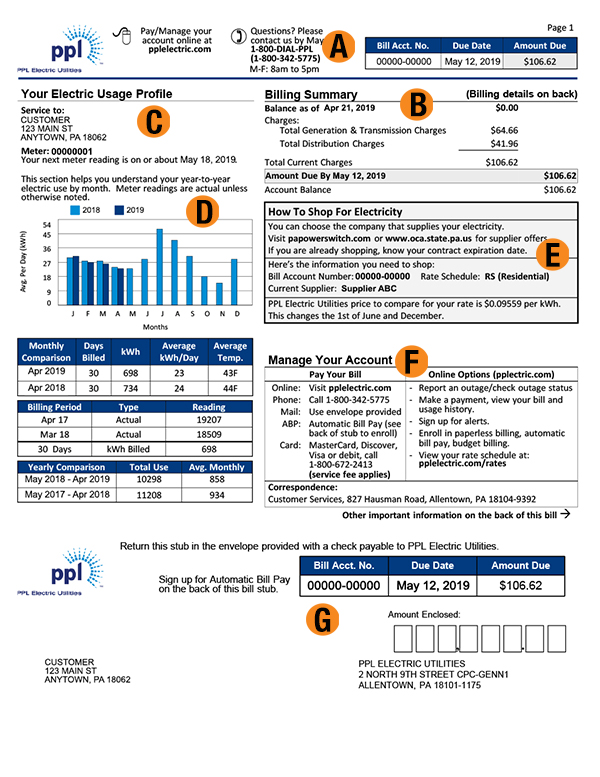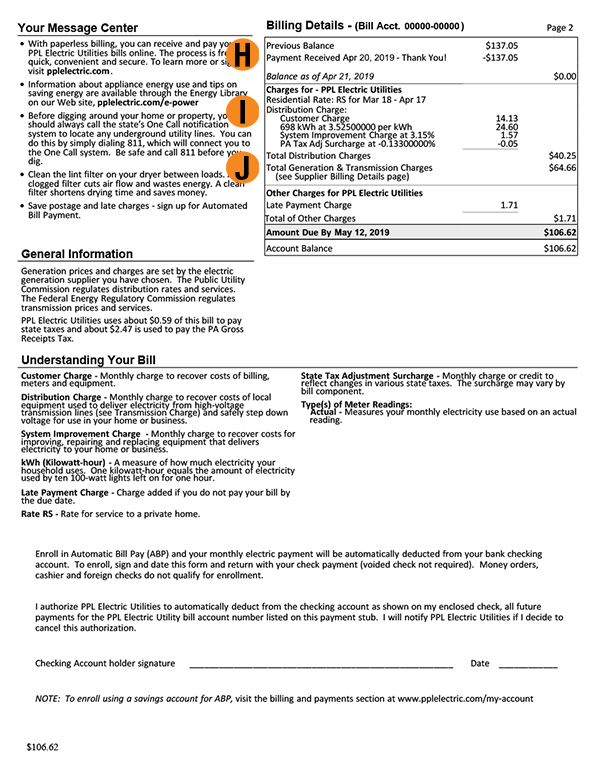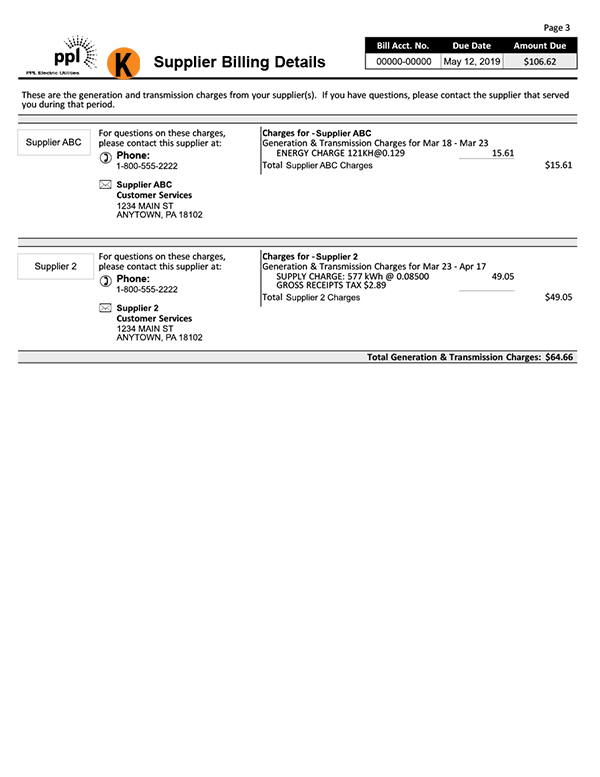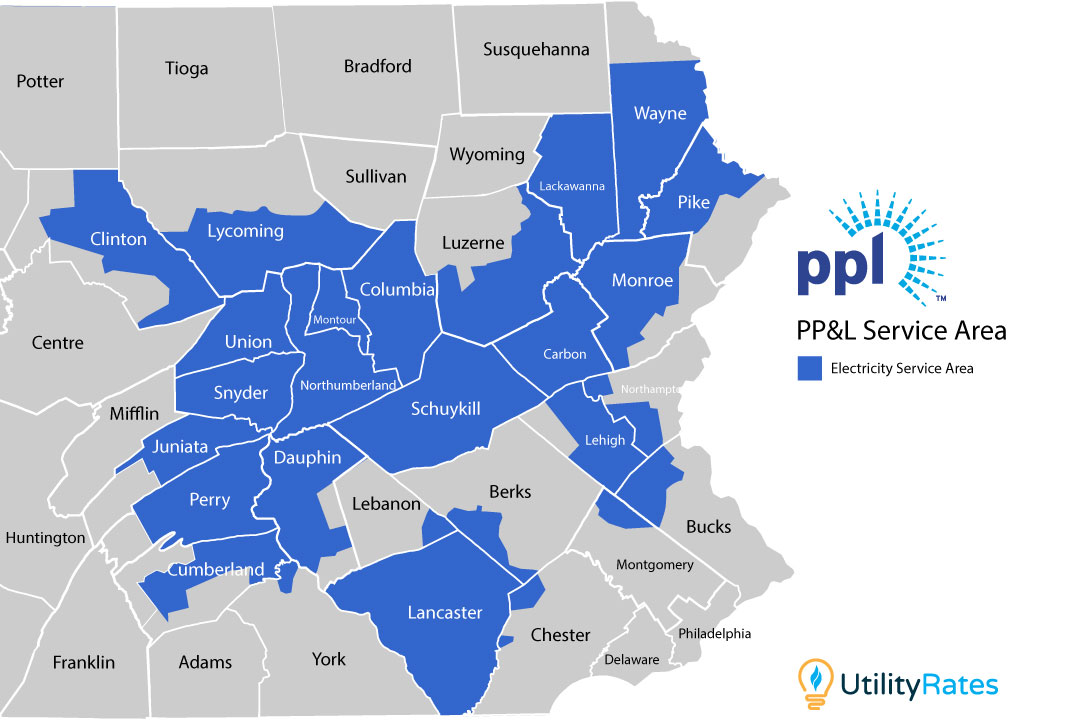Compare the Best PP&L Energy Rates
Find the lowest PP&L rates.
Select a Service Type and Enter Your ZIP Code to Get Started
Rated 5/5
Based on over 41,000 reviews
40%
Save up to 40%
100+
Electricity Providers
40+
Natural Gas Providers
PP&L Service Area Map
PP&L serves more than 1.4 million customers in central and eastern Pennsylvania.
Cities served by PP&L
PP&L serves: Allentown, Bethlehem, Harrisburgh, Wilke-Barre, Scranton across 30 counties in central and eastern Pennsylvania.
Price Alert!
The lowest 12 month fixed electricity rate in the PP&L service area is 12.490¢ per kWh. That is 9.6% lower than PPL's Price to Compare rate of 12.49¢.
Compare The Best PP&L Electricity Rates
We've researched the best providers and plans so you can find a great electricity rate in Pennsylvania
| Company | Term | Rate |
|---|---|---|
| American Power & Gas | 1/months | 7.3¢/kWh |
| Major Energy | 6/months | 12.4¢/kWh |
| Public Power | 12/months | 12.5¢/kWh |
| Verde Energy | 6/months | 12.5¢/kWh |
| APG&E | 6/months | 12.7¢/kWh |
| Direct Energy | 7/months | 12.8¢/kWh |
| Think Energy | 12/months | 12.9¢/kWh |
| Constellation | 8/months | 13.6¢/kWh |
| Energy Harbor | 12/months | 14.0¢/kWh |
| Santanna Energy Services | 12/months | 14.3¢/kWh |
| Company | Term | Rate |
|---|---|---|
| Indra Energy | 2/months | 10.4¢/kWh |
| XOOM Energy | 6/months | 12.1¢/kWh |
| NRG Home | 12/months | 14.7¢/kWh |
| CleanSky Energy | 24/months | 16.0¢/kWh |
| Company | Term | Rate |
|---|---|---|
| Frontier Utilities | 12/months | 12.5¢/kWh |
Compare PP&L Business Electricity Rates
You have the power to choose your Commercial and PP&L Small Business Electricity Rates. The Utility Rates commercial electricity marketplace is exclusively for business electricity customers looking to start commercial service or compare their existing commercial electricity rates.
PP&L business electricity rates are some of the lowest in the US and are 20-30% less than residential rates. So, if you're starting a business or just want to compare PP&L commercial electricity rates and shop the market for a better rate, you could save thousands each year by shopping for a lower rate.
PP&L Commercial Electricity Rates
What is the PPL Price to Compare (PTC)?
The Price to Compare is the price the utility pays generator companies for electricity. It includes the price to generate the electricity, as well as the cost to transmit it over high voltage transmission power lines to PP&Ls local electrical switch yards. From there, the electricity is distributed throughout the PP&L controlled grid for delivery to homes.
PP&L sets its PTC rates by holding auctions 4 times per year: March 1, June 1, September 1, and December 1. As a result, PP&L's PTC rates change every three months. Additionally, when the auctions are over, the PA PUC must approve the prices for both the generation supply and transmission.
PPL's Price to Compare is 12.49¢
For customers, PTC electricity rates fluctuated throughout the year and can vary with the seasons; low some months, and higher during others. To learn more see our detailed analysis of PPL's Price to Compare, below
PP&L Price to Compare - Historical Rates 2014-2025
Learn More - PP&L's Price to Compare - Analysis 2014-2025
PPL Rates: 7.04-8.49 ¢/kWh
Natural gas production in the US reached record levels due to the shale gas revolution, keeping wholesale prices low. This was the golden age of affordable energy before the crisis years. The market was stable, predictable, and primarily domestic-focused.
What Happened: A severe winter storm hit Texas and Oklahoma, causing widespread natural gas production freeze-offs.
Impact: Natural gas prices briefly spiked and remained elevated through October 2021 as economic recovery increased demand faster than supply could respond. Storage inventories remained depleted throughout the year.
Why It Mattered: This event set the stage for 2022's crisis by depleting storage and demonstrating infrastructure vulnerabilities to extreme weather.
PPL Rate Jump: +26% increase (7.54¢ 9.50¢/kWh)
What Happened: Russia began restricting gas supplies to Europe in late 2021, causing European natural gas prices to soar by over 500%.
Impact: Global LNG demand increased dramatically, pulling US gas into international markets and raising domestic prices. This was the first clear signal that US consumers would be affected by European energy issues.
The Trigger Event: Russia's full-scale invasion triggered the first truly global energy crisis.
Key Facts:
- Russia supplied 45% of EU's natural gas imports before the war
- European gas prices reached levels 10x higher than the previous 15-year average
- US became Europe's crucial LNG supplier overnight
- Russia reduced exports to Europe by 150 billion cubic meters in 2022
Cascading Effects: The weaponization of energy supply caused a fundamental restructuring of global gas markets. US natural gas, previously isolated from world prices, became permanently linked to international events.
What Happened: An explosion shut down the Freeport LNG terminal in Texas, representing 17% of US LNG export capacity (~2 Bcf/d).
The Paradox:
- Initially predicted to reopen in weeks, stayed offline until February 2023
- US domestic natural gas prices temporarily fell (oversupply dropped prices from $9.85 to $6.54/MMBtu)
- European prices remained elevated (less LNG available)
- Electricity rates continued rising due to earlier contracted high gas prices
Duration: The facility took 8 months to return to service, exacerbating Europe's energy crisis during a critical period.
Crisis Metrics:
- Henry Hub natural gas: $9.85/MMBtu (peak on Aug 22)
- Historical price volatility: 171% (highest since 1994)
- European natural gas: exceeded 200/MWh
- Annual 2022 average: $6.45/MMBtu (highest since 2008)
What Happened: Unprecedented uncertainty as Europe scrambled for LNG alternatives to Russian pipeline gas. The convergence of the Ukraine war, Freeport outage, and surging global demand created perfect storm conditions.
PPL Rate Progression:
- November 2022: 12.37¢/kWh (+38% increase)
- May 2023: 14.61¢/kWh (+18% increase, all-time high)
- Total increase from May 2022: +63%
The Lag Effect: Electricity rates peaked in early 2023 even as natural gas prices had begun falling. This occurs because utilities purchase gas on long-term contracts and pass through costs to customers with significant delay.
Context: Average 2022 US natural gas prices were up 53% from 2021, the highest since 2008. These extreme wholesale costs took months to fully flow through to retail electricity bills.
Price Decline:
- Natural gas fell 41% in January 2023
- Average 2023 Henry Hub: $2.66/MMBtu vs $6.54/MMBtu in 2022
- European gas prices dropped from 200+ to ~30/MWh by August
- Europe's gas storage reached record highs (90%+ full)
Why Prices Fell: Warmer-than-average temperatures, increased US production, higher storage inventories, and successful European diversification away from Russian gas.
PPL Response: Rates began declining from peak but remained 70% higher than 2019 levels, reflecting the new structural reality of energy markets.
Current State:
- PPL rates stabilized: 10-12.5¢/kWh range
- 2024 Q1 natural gas: $2.10/MMBtu (near record lows)
- 2025-26 forecast: $3.00-4.10/MMBtu
- Price volatility still 50% above pre-2022 levels
Structural Changes:
- US LNG export capacity set to nearly double by 2028
- Permanent shift away from Russian pipeline gas
- US domestic prices now tied to global events
- Europe maintains 90%+ gas storage as buffer
Why Rates Won't Return to 2019: The globalization of US natural gas markets, increased infrastructure costs, ongoing geopolitical tensions, and renewable energy transition investments create a permanently higher price floor.
How to Start New PPL Service
To start service with PPL, go to their Start, Stop, Or Move Service web page. Select a date up to 40 days in advance, and provide proof of ID to start service. Valid forms of identification include a driver's license, state-issued photo ID card, passport, resident card, visa, or a military ID.
PPL may check your credit, and charge a deposit to start service based on your credit history. Not everyone will require a security deposit, and in some instances, the security deposit may be waived.
You'll need to give the following information when you apply for service:
- Name
- Date of birth
- Address where electricity service is needed
- Phone number
- Social Security number
Will I need to pay a deposit?
Pennsylvania electric utilities can charge a deposit based on a customer's credit worthiness. The amount cannot be greater than two months of estimated usage. Customers have 21 days after the utility sends the deposit request notification to make a payment. However, customers have three months to pay the full deposit.
Customers can contact PPL customer service at 1-800-342-5775 or via the PPL Customer Service webpage.
How to switch PP&L suppliers
PP&L consumers may choose their own competitive retail electricity suppliers. These alternative suppliers shop deals on the wholesale market to offer competitive rates.
The PTC rate is important to know when shopping Pennsylvania electricity plans as it provides a price for a set period of time to compare with retailer's prices. This way, you can compare the relative costs of electricity over both the short term and long term.
You will need your PP&L Account Number (See Bill Image) to switch suppliers.
When you're shopping for retail suppliers, you can choose a fixed rate, or a variable rate plan.
- Fixed rates offer a set in stone supply price that will not change over the course of your contract.
- A variable rate changes periodically depending on the current market value of electricity.
Some suppliers offer plans with renewable energy sources or other greener options such as investing back into solar or wind energy. Additionally, keep an eye out for any kind of perks or deals you may be able to take advantage of. Some retailers may offer reimbursement in the form of gift cards, discounts, or specialty pricing if conditions are met.
PPL Shopping Questions
The best way for a PPL energy customer to avoid making a bad choice is to ask the right questions. That way, you can learn exactly the information that can save you money. When you shop for electricity service in Pennsylvania, always be sure to ask these important questions:- Is the rate variable or is it fixed?
- Is the rate competitive with the current PPL supply rate?
- How long is the contract?
- Does the plan's contract term last longer than PPL's PTC rate?
- Are there any recurring monthly charges?
- Are there any restrictions on the rate being offered? These can be things like new customers only, active military only, seniors only, etc.
- Does the plan have an early cancellation fee?
- Are there any incentives or rewards programs? Do they fit your lifestyle?
- Does the contract automatically renew? If so, what are your options?
Understand Deregulation in Pennsylvania
When Pennsylvania deregulated its energy market in 1997, customers were allowed to shop around for their electricity supplier, rather than be bound to the local utility rate. However, each utility taking part had to sell off their generators and become delivery-only companies.
To protect energy customers from service disruptions the PA PUC requires utilities to provide electricity supply at a default rate without mark up to customers who choose not to shop for a retail supplier.
These utility default rates are also called the "Price to Compare" or PTC. These rates are overseen by the PA PUC.
What is the difference between PPL and a retail electricity supplier?
The primary difference between PPL and an electricity supplier is that PPL owns and maintains the distribution network of poles, lines, and meters that bring electricity to your home.
Customers should contact PPL when they have a problem with their billing or cannot pay the amount due according to their monthly statement. They should also contact PPL in case of an emergency or outage.
Lastly, PPL is the last resort supplier if your supplier stops serving customers in PA.
What are PPL delivery and supply charges?
Pennsylvania residential customers now pay separate charges for the cost to deliver their electricity and for the amount of electricity supply that they use.
How to Read Your PPL Bill



- A: Account Information. This includes your name, 10 digit PPL account number, the bill's due date period, and the payment amount due.
- B : Billing Summary. This shows an overview of account balances, current charges, the date due, and the amount due.
- C: Electric Usage Profile. The first part shows the service address, the meter number for that address, and the date of the next meter read.
- D: The second part of the Electric Usage Profile shows the average daily usage over the past 24 months, as well as monthly usage comparisons and average temperatures. This feature helps you understand how well your home heats and cools.
- E: The Shopping Guide. This shows information you'll provide to an electricity supplier: your PPL account number, the rate schedule ( RS = residential service), and PPL's current PTC rate.
- F: Manage Your Account. These resources help you pay your bill and manage your account online.
- G: Bill Stub. The payment stub shows information to credit your payment to your account if you mail your monthy payment to PPL.
- H: Page 2 shows important details about your PPL bill. These include the previous balance due and the date and amount of the payment received.
- I: Charges Due. These show the amounts that make up the distribution portion of your bill.
- J: Electricity Supply Charges Due. This shows the generation and transmission charges. Details are spelled out on Page 3.
- K: Page 3 of your PPL bill contains your electricity supplier's billing details. It shows the generation and transmission charges per kWh for the billing period, any monthly charges, and taxes.
Ready to choose your energy rate?
Enter your ZIP code to explore the best energy plans in your area. Compare energy rates side by side, and choose the one that fits your home and budget.







